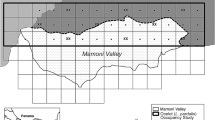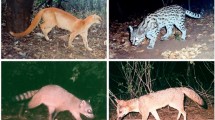Abstract
Understanding the distribution and habitat preference of threatened species is essential for their conservation. We conducted the first systematic camera trap survey of the Vulnerable northern tiger cat Leopardus tigrinus in Caatinga drylands (Brazil) and tested how its occupancy and detectability patterns are affected by environmental and anthropogenic factors. Species detection-non-detection data, obtained by 7263 camera-days distributed throughout 187 sampling sites on ten Caatinga landscapes, were used to evaluate species detectability and occupancy according to ten environmental and anthropogenic predictors. We built seven detection models and 30 hierarchical occupancy models that have been ranked based on the Akaike Information Criterion. The estimated average occupancy of 0.46 was 38% higher than the naïve occupancy rate (0.34). Species occupancy was higher in locations with greater forest cover and at greater distance to agrarian settlements. Hunting and persecution of northern tiger cats by residents and a possible reduction of their natural prey by hunting may explain the result. On the contrary, more forested environments may represent higher-quality habitats providing greater availability of prey and shelters and protection against anthropogenic threats and extreme temperatures. These results improve the understanding of the ecology of a threatened and poorly known small cat, and they can guide conservation actions such as the creation of dense forest protected areas and provide information for mitigating human-carnivore conflict.


Similar content being viewed by others
Change history
04 October 2017
The original version of this article, unfortunately, contained an error.
References
Antongiovanni M (2017) Fragmentação, Conservação e Restauração da Caatinga. PhD thesis, Universidade do Rio Grande do Norte, Brazil
Ab’Sáber AN (1974) O domínio morfoclimático semi-árido das caatingas brasileiras. Geomorfologia 43:1–36
Alves RRN, Gonçalves MBR, Vieira WLS (2012) Caça, uso e conservação de vertebrados no semiárido Brasileiro. Trop Conserv Sci 5:394–416 http://www.tropicalconservationscience.org
Alves RRN, Mendonça LET, Confessor MVA, Vieira WLS, Lopez LCS (2009) Hunting strategies used in the semi-arid region of northeastern Brazil. J Ethnobiol Ethnomed 5:1–16. doi:10.1186/1746-4269-5-12
Astete S, Marinho-Filho J, Machado RB, Zimbres B, Jácomo ATA, Sollmann R, Tôrres NM, Silveira L (2017) Living in extreme environments: modelling habitat suitability for jaguars, pumas, and their prey in a semiarid habitat. J Mammal 98:464–474. doi:10.1093/jmammal/gyw184
Beuchle R, Grecchi RC, Shimabukuro YE, Seliger R, Eva HD, Sano E, Achard F (2015) Land cover changes in the Brazilian Cerrado and Caatinga biomes from 1990 to 2010 based on a systematic remote sensing sampling approach. Appl Geogr 58:116–127. doi:10.1016/j.apgeog.2015.01.017
Burnham KP, Anderson DR (2002) Model selection and multimodel inference. Springer, New York, USA
Cardillo M, Puvis A, Sechrest W, Gittleman JL, Bielby J, Mace GM (2004) Human population density and extinction risk in the world’s carnivores. PLoS Biol 2:909–914. doi:10.1371/journal.pbio.0020197
Ceballos G, Brown JH (1995) Global patterns of mammalian diversity, endemism, and endangerment. Conserv Biol 9:559–568 http://www.jstor.org/stable/2386610
CITES (2015) Convention on International Trade in Endangered Species of Wild Fauna and Flora. Appendices I, II and III. http://www.cites.org/eng/app/appendices.php. Accessed 25 Aug 2016
Crooks KR, Soulé ME (1999) Mesopredator release and avifaunal extinctions in a fragmented system. Nature 400:563–566. doi:10.1038/23028
De Paula RC, Campos CB, Oliveira TG (2012) Red List assessment for the jaguar in the Caatinga biome. Cat News 7:19–24
Delciellos AC (2016) Mammals of four Caatinga areas in northeastern Brazil: inventory, species biology, and community structure. Check List 12:1916. doi:10.15560/12.3.1916
De Wan AA, Sullivan PJ, Lembo AJ, Smith CR, Maerz JC, Lassoie JP, Richmond ME (2009) Using occupancy models of forest breeding birds to prioritize conservation planning. Biol Conserv 142:982–991. doi:10.1016/j.biocon.2008.12.032
Di Bitetti MS, Paviolo A, De Angelo C (2006) Density, habitat use and activity patterns of ocelots (Leopardus pardalis) in the Atlantic Forest of Misiones, Argentina. J Zool 270:153–163. doi:10.1111/j.1469-7998.2006.00102.x
Feijó A, Langguth A (2013) Mamíferos de Médio e Grande Porte do Nordeste do Brasil: Distribuição e Taxonomia, com Descrição de Novas Espécies. Rev Nordestina Biol 22:3–225
Fernandes-Ferreira H (2014) A Caça no Brasil. PhD thesis, Universidade Federal da Paraíba, Brazil
Freitas RR, Rocha PLB, Simões-Lopes PC (2008) Habitat structure and small mammals abundances in one semiarid landscape in the Brazilian Caatinga. Rev Bras Zool 22:119–129. doi:10.1590/S0101-81752005000100015
Gálvez N, Hernández F, Laker J, Gilabert H, Pepitas R, Bonacic C, Gimona A, Hester D, Macdonald W (2013) Forest cover outside protected areas plays an important role in the conservation of the Vulnerable guiña Leopardus guigna. Oryx 47:251–258. doi:10.1017/S0030605312000099
Hansen MC, Potapov PV, Moore R, Hancher M, Turubanova SA, Tyukavina A, Thau D, Stehman SV, Goetz SJ, Loveland TR, Kommareddy A, Egorov A, Chini L, Justice CO, Townshend JRG (2013) High-resolution global maps of 21st-century forest cover change. Science 342:850–853. doi:10.1126/science.1244693
Hines JE (2006) Presence 2: software to estimate patch occupancy and related parameters. U.S. Geological Survey, Patuxent Wildlife Research Center, Laurel, Maryland. http://www.mbr-pwrc.usgs.gov/software/presence.html
Konecny MJ (1987) Food habits and energetics of feral house cats in the Galápagos Islands. Oikos 50:24–32. doi:10.2307/3565398
Leal IR, Silva JMC, Tabarelli M, Lacher-Jr TR (2005) Changing the course of biodiversity conservation in the Caatinga of northeastern Brazil. Conserv Biol 19:701–706. doi:10.1111/j.1523-1739.2005.00703.x
Linkie M, Dinata Y, Nugroho A, Haidir IA (2007) Estimating occupancy of a data deficient mammalian species living in tropical rainforests: sun bears in the Kerinci Seblat region, Sumatra. Biol Conserv 137:20–27. doi:10.1016/j.biocon.2007.01.016
Long RA, Donovan TM, Mackay P, Zielinski WJ, Buzas JS (2011) Predicting carnivore occurrence with noninvasive surveys and occupancy modelling. Landsc Ecol 26:327–340. doi:10.1007/s10980-010-9547-1
MacKenzie DI, Bailey LL (2004) Assessing the fit of site-occupancy models. J Agric Biol Envir St 9:300–318. doi:10.1198/108571104X3361
MacKenzie DI, Nichols JD, Lachman GB, Droege S, Royle JA, Langtimm CA (2002) Estimating site occupancy rates when detection probabilities are less than one. Ecology 83:2248–2255. doi:10.1890/0012-9658(2002)083[B2248:ESORWD]2.0.CO;2
MacKenzie DI, Nichols JD, Royle JA, Pollock KH, Bailey LL, Hines JE (2006) Occupancy estimation and modelling: inferring patterns and dynamics of species occurrence. Elsevier, San Diego
Marinho FP, Mazzochini GG, Manhães AP, Weisser WW, Ganade G (2016) Effects of past and present land use on caatinga cover and regeneration in a tropical dryland forest. J Arid Environ 132:26–33. doi:10.1016/j.jaridenv.2016.04.006
Marinho PH, Feijó A, Galivan AS, Moura EO, Venticinque EM (2017) First records of Ocelot Leopardus pardalis (Linnaeus, 1758) (Carnivora: Felidae) from Rio Grande do Norte, northeastern Brazil. Check List 13:2087. doi:10.15560/13.2.2087
Mendonça LET, Souto CM, Andrelino LL, Souto WMS, Vieira WLS, Alves RRN (2011) Conflitos entre pessoas e animais silvestres no Semiárido paraibano e suas implicações para conservação. Sitientibus série Cienc Biol 11:185–199
Miller DAW, Grant EHC (2015) Estimating occupancy dynamics for large-scale monitoring networks: amphibian breeding occupancy across protected areas in the northeast United States. Ecol Evol 5:4735–4746. doi:10.1002/ece3.1679
MMA (2011) Monitoramento do desmatamento nos biomas brasileiros por satélite - monitoramento do bioma Caatinga 2008–2009. Ministério do Meio Ambiente, IBAMA, Brasília. http://www.mma.gov.br/estruturas/sbf_chm_rbbio/_arquivos/relatorio_tecnico_caatinga_2008_2009_72.pdf
MMA (2014) Listas das Espécies da Fauna Brasileira Ameaçadas de Extinção vigentes. Ministério do Meio Ambiente. http://www.mma.gov.br/. Accessed 17 Dezember 2014
MMA (2016) Áreas Prioritárias para a Conservação, Utilização Sustentável e Repartição de Benefícios da Biodiversidade do Cerrado, do Pantanal e da Caatinga Ministério do Meio Ambiente. http://wwwmmagovbr/biodiversidade/biodiversidade-brasileira/%C3%A1reas-priorit%C3%A1rias/item/10724. Accessed 05 Sept 2016
O’Connell AF, Bailey LL (2011) Inference for occupancy and occupancy dynamics. In: O’Connel AF, Nichols JD, Karanth KU (eds) Camera traps in animal ecology: methods and analyses. Springer, Tokyo Dordrecht Heidelberg London New York, pp 191–206
Oliveira TG, Tortato MA, Almeida LB, Campos CB, Beisiegel BM (2013) Avaliação do risco de extinção do gato-do-mato Leopardus tigrinus (Schreber, 1775) no Brasil. Biodiv Brasil 3:56–65
Oliveira TG, Tortato MA, Silveira L, Kasper CB, Mazim FD, Jácomo ATA, Lucherini M, Soares JBG, Marques RV, Sunquist M (2010) Ocelot ecology and its effect on the small-felid guild in the lowland Neotropics. In: Macdonald DW, Loveridge AJ (eds) Biology and conservation of the wild felids. Oxford University Press, New York, pp 559–580
Overbeck GE, Vélez-Martin E, Scarano FR, Lewinsinhn TM, Fonseca CR, Meyer ST, Müller SC, Ceotto P, Dadalt L, Durigan G, Ganade G, Gossner MM, Guadagnin DL, Lorenzen K, Jacobi CM, Weisser WW, Pillar VD (2015) Conservation in Brazil needs to include non-forest ecosystems. Divers Distrib 21:1455–1460. doi:10.1111/ddi.12380
Payan E, Oliveira T (2016) Leopardus tigrinus. The IUCN Red List of Threatened Species 2016:e.T54012637A50653881 doi:10.2305/IUCN.UK.2016-2.RLTS.T54012637A50653881.en. Accessed 17 Nov 2016
Pereira JA, Fracassi NG, Rago V, Ferreyra H, Marull A, Mcaloose D, Uhart MM (2010) Causes of mortality in a Geoffroy’s cat population—a long-term survey using diverse recording methods. Eur J Wildlife Res 56:939–942. doi:10.1007/s10344-010-0423-8
Pia MV, Renison D, Mangeaud A, De Angelo C, Haro JG (2013) Occurrence of top carnivores in relation to land protection status, human settlements and rock outcrops in the high mountains of central Argentina. J Arid Environ 91:31–37. doi:10.1016/j.jaridenv.2012.11.004
R Core Team (2016) R: a language and environment for statistical computing. R Foundation for Statistical Computing, Vienna, Austria. https://www.R-project.org/
Santos AM, Tabarelli M (2002) Distance from roads and cities as a predictor of habitat loss and fragmentation in the Caatinga vegetation of Brazil. Braz J Biol 62:897–905. doi:10.1590/S1519-69842002000500020
Sales RFD, Ribeiro LB, Jorge JSS, Freire EMX (2011) Habitat use, daily activity periods, and thermal ecology of Ameiva ameiva (Squamata: Teiidae) in a Caatinga area of northeastern Brazil. Phyllomedusa 10:165–176. doi:10.11606/issn.2316-9079.v10i2p165-176
Sarmento PB, Cruz J, Eira C, Fonseca C (2011) Modelling the occupancy of sympatric carnivorans in a Mediterranean ecosystem. Eur J Wildlife Res 57:119–131. doi:10.1007/s10344-010-0405-x
Schneider M, Peres CA (2015) Environmental costs of government-sponsored agrarian settlements in Brazilian Amazonia. PLoS One 10:e0134016. doi:10.1371/journal.pone.0134016
Sousa MA, Langguth A, Gimenez EA (2004) Mamíferos dos Brejos de Altitude Paraíba e Pernambuco. In: Porto KC, Cabral JJP, Tabarelli M (eds) Brejos de altitude em Pernambuco e Paraíba: história natural, ecologia e conservação. Ministério do Meio Ambiente, Brasília, pp 229–254
Tobler MW (2007) Camera base version 1.6. Atrium biodiversity information system. http://www.atrium-biodiversity.org/tools/camerabase/
Trigo TC, Schneider A, Oliveira TG, Lehugeur LM, Silveira L, Freitas LM, Eizirik E (2013) Molecular data reveal complex hybridization and a cryptic species of neotropical wild cat. Curr Biol 23:2528–2533. doi:10.1016/j.cub.2013.10.046
Velloso AL, Sampaio EVSB, Pareyn FGC (2002) Ecorregiões Propostas para o Bioma Caatinga. Associação Plantas do Nordeste, Instituto de Conservação Ambiental, The Nature Conservancy do Brasil, Recife, Brazil
Zanin M, Palomares FP, Brito D (2015) What we (don’t) know about the effects of habitat loss and fragmentation on felids. Oryx 49:96–106. doi:10.1017/S0030605313001609
Acknowledgements
We are grateful to Wildlife Conservation Society—Brazil and the Centro de Pesquisas Ambientais do Nordeste (CEPAN) for the partnership; Tropical Conservation Act (TFCA) through Brazilian Biodiversity Fund (Call 04/2012) and Fundação Grupo Boticário de Proteção à Natureza (Project 0982-20132) for financial support; A.F. Oliveira, D. Valdenor, M.C. Bezerra, A. Galvão, F.P. Marinho, W. Pessoa, and T.G. Oliveira for assistance in the field or in the data analysis. We are immensely grateful to J.B. de Lima (seu João) and other local residents of the Caatinga for their hospitality and essential field assistance. We also thank M.P. Pinto and S. Astete, two anonymous reviewers, and associate editor for their valuable suggestions. PHM (130648/2013-2), CRF (305304/2013-5), and EMV (309458/2013-7) were funded by CNPq (Brazil) and, DB and MAF were funded by CAPES (Brazil).
Author information
Authors and Affiliations
Corresponding author
Additional information
Communicated by: Krzysztof Schmidt
The original version of this article was revised: In the “Results” section originally reading “...significant lack of fit (test statistic = 144.83, p = 0.29)”, this should instead have read “...significant lack of fit “(c ^ = 0.95; Test statistic = 144.83, p = 0.29)”. [bold text used to highlight problem area]
An erratum to this article is available at https://doi.org/10.1007/s13364-017-0335-z.
Electronic supplementary material
ESM 1
(DOCX 795 kb)
Rights and permissions
About this article
Cite this article
Marinho, P.H., Bezerra, D., Antongiovanni, M. et al. Estimating occupancy of the Vulnerable northern tiger cat Leopardus tigrinus in Caatinga drylands. Mamm Res 63, 33–42 (2018). https://doi.org/10.1007/s13364-017-0330-4
Received:
Accepted:
Published:
Issue Date:
DOI: https://doi.org/10.1007/s13364-017-0330-4




